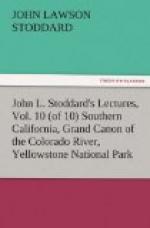[Illustration: OLD HANCE.]
[Illustration: THE FIRST VIEW.]
Early the next morning I eagerly climbed the little knoll at the foot of which our tents were located, for I well knew that from its summit I should see the Canon. Many grand objects in the world are heralded by sound: the solemn music of Niagara, the roar of active geysers in the Yellowstone, the intermittent thunder of the sea upon a rocky coast, are all distinguishable at some distance; but over the Grand Canon of the Colorado broods a solemn silence. No warning voice proclaims its close proximity; no partial view prepares us for its awful presence. We walk a few steps through the pine trees from the camp and suddenly find ourselves upon the Canon’s edge. Just before reaching it, I halted for a moment, as has always been my wont when approaching for the first time any natural or historic object that I have longed for years to look upon. Around me rose the stately pines; behind me was a simple stretch of rolling woodland; nothing betrayed the nearness of one of the greatest wonders of the world. Could it be possible that I was to be disappointed? At last I hurried through the intervening space, gave a quick look, and almost reeled. The globe itself seemed to have suddenly yawned asunder, leaving me trembling on the hither brink of two dissevered hemispheres. Vast as the bed of a vanished ocean, deep as Mount Washington, riven from its apex to its base, the grandest canon on our planet lay glittering below me in the sunlight like a submerged continent, drowned by an ocean that had ebbed away. At my very feet, so near that I could have leaped at once into eternity, the earth was cleft to a depth of six thousand six hundred feet—not by a narrow gorge, like other canons, but by an awful gulf within whose cavernous immensity the forests of the Adirondacks would appear like jackstraws, the Hudson Palisades would be an insignificant stratum, Niagara would be indiscernible, and cities could be tossed like pebbles.




